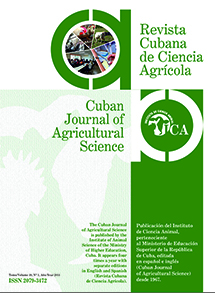Evaluation of the productive response of male cattle to the substitution of corn grain by different levels of fresh sweet potato tuber (Ipomoea batatas L.) in a fattening diet
Contenido principal del artículo
Resumen
The productive response to the substitution of milled corn grain by fresh sweet potato tuber (I. batatas) in a ration destined to fattening steers was evaluated. A completely random design with a 3 x 2 factorial arrangement was used. The study lasted 78 days and three substitution levels were evaluated on a dry basis: 0, 50 and 100 % (TL0, TL50 and TL100, respectively), and two evaluation periods. The diets were isoenergetic and isoprotein. A total of four crossbreed males, with an average initial weight of 358 + 23 kg were used per treatment. The live weight gain was 1.620, 1.670 and 1.756 kg animal day-1 for TL0, TL50 and TL100. The intake of dry matter, fresh tuber and crude protein was 2.66, 2.67 and 2.76 kg; 0.00, 0.76 and 1.56 kg DM; 0.303, 0.296 and 0.305 kg; while the metabolizable energy intake resulted 29.50, 29.16 and 29.00 MJ 100 kg of live weight day-1 and the food conversion, 6.88, 6.68 and 6.62 kg of dry matter intake per kg of live weight gain-1 for TL0, TL50 and TL100. The cost of the fresh sweet potato tuber and the substitution of the milled corn grain was $ 0.18 and 0.40 kg dry-1 (US dollars). With respect to TL0, the feeding cost was reduced by 18.0 and 28.3 % with TL50 and TL100. It is concluded that the fresh sweet potato tuber proved to be a competitive and economically viable nutritional alternative, as an energy source for the replacement of 100 % of the corn grain in diets for fattening male cattle.
Key words: Tainung 66, sweet potato tuber, weight gain, intake, food conversion, feeding cost
Key words: Tainung 66, sweet potato tuber, weight gain, intake, food conversion, feeding cost
Detalles del artículo
Cómo citar
Ruiloba, M. H., Maure, J., & Solis, C. (2021). Evaluation of the productive response of male cattle to the substitution of corn grain by different levels of fresh sweet potato tuber (Ipomoea batatas L.) in a fattening diet. Cuban Journal of Agricultural Science, 55(4). Recuperado a partir de https://mail.cjascience.com/index.php/CJAS/article/view/1033
Sección
Ciencia Animal
Aquellos autores/as que tengan publicaciones con esta revista, aceptan los términos siguientes:
- Los autores/as conservarán sus derechos de autor y garantizarán a la revista el derecho de primera publicación de su obra, el cuál estará simultáneamente sujeto a la Licencia Creative Commons Attribution-NonCommercial 4.0 International (CC BY-NC 4.0) que permite a terceros compartir la obra siempre que se indique su autor y su primera publicación esta revista. Bajo esta licencia el autor será libre de:
- Compartir — copiar y redistribuir el material en cualquier medio o formato
- Adaptar — remezclar, transformar y crear a partir del material
- El licenciador no puede revocar estas libertades mientras cumpla con los términos de la licencia
Bajo las siguientes condiciones:
- Reconocimiento — Debe reconocer adecuadamente la autoría, proporcionar un enlace a la licencia e indicar si se han realizado cambios. Puede hacerlo de cualquier manera razonable, pero no de una manera que sugiera que tiene el apoyo del licenciador o lo recibe por el uso que hace.
- NoComercial — No puede utilizar el material para una finalidad comercial.
- No hay restricciones adicionales — No puede aplicar términos legales o medidas tecnológicas que legalmente restrinjan realizar aquello que la licencia permite.
- Los autores/as podrán adoptar otros acuerdos de licencia no exclusiva de distribución de la versión de la obra publicada (p. ej.: depositarla en un archivo telemático institucional o publicarla en un volumen monográfico) siempre que se indique la publicación inicial en esta revista.
- Se permite y recomienda a los autores/as difundir su obra a través de Internet (p. ej.: en archivos telemáticos institucionales o en su página web) antes y durante el proceso de envío, lo cual puede producir intercambios interesantes y aumentar las citas de la obra publicada. (Véase El efecto del acceso abierto).
